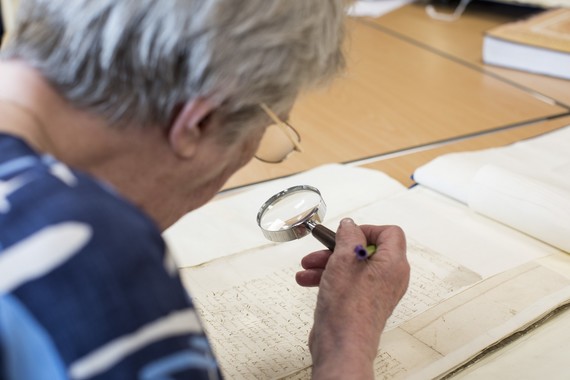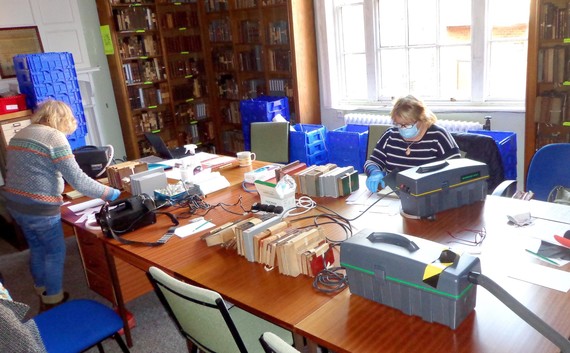 Thank you to all our volunteers for your hard work this year, whether you have been volunteering remotely at home or have come back in to the Archives and Heritage Service buildings.
We appreciate the challenges that this year has brought. In the summer it was lovely to welcome you back into the building and you have been so cooperative regarding the precautions that we’ve had to keep in place. Our new Volunteer Coordinator Mel, has been settling into her role and has felt really welcomed by all the groups and those working remotely.
Our Quarter Session volunteers have worked very hard recording content of 17th century rolls. They are currently in the process of checking each other’s drafts, a process that was delayed by lockdown. The group met over Zoom during the lockdown period and looked forward to getting back to the documents when we came back in July. Sadly this year the group lost Diana Hill, who had been unwell for some time. She had volunteered with us for many years and was much loved in the group. Her partner Mike told us that Diana had said that she missed going in and the company, and was sending the group her best wishes. She was described by her group as ‘an absolute star’. Diana’s contribution to making Staffordshire heritage accessible will be a long-lasting legacy and she will be very much missed by all who worked with her.
Our Bawdy Courts of Lichfield group had been meeting virtually over the lockdowns too, working with Collections Officer, Rebecca Jackson and PhD student Susie Johns from Keele University. They have been working through the fascinating consistory court papers and revealing 17th century Staffordshire history in the words of ordinary people. Some of the group continue to work remotely and research for our blog. Susie also leads the group on a Tuesday morning at Staffordshire Record Office, where volunteers practice their palaeography skills, working through a range of church court cases. This work has enhanced Service catalogues and will improve access to the collection.
Andrew Sargent, leads the Victoria County History Group on Wednesday mornings. The volunteers working on the collaboration with the Victoria County History have continued their work on researching Uttoxeter and surrounds. The VCH study day took place online at the end of October and was very well attended.
The Staffordshire Place Names group has relaunched at Staffordshire Record Office after an introductory study day in November with the University of Nottingham. The group is working through the end of the Glebe Terriers, right the way through to Yoxall, and will move on to a different collection in the new year. They are collecting data for the project, uploading it onto the University of Nottingham’s data gathering site, supported by Mel, our Volunteer Coordinator wearing her other hat as the Place Names Project Assistant.
The Asylum project began in January 2019. It aims to help provide an understanding of the history of mental health care in Staffordshire and is funded by the Wellcome Trust. Records of the three former County Asylums, Stafford, Burntwood and Cheddleton, have been catalogued to create a database of information that reflects patient experience in the asylums. PhD researcher Lucy Smith, is leading the group on Thursday mornings as they research case files from Cheddleton, looking for photographs, letters and other ephemera, and discussing interesting cases for our asylums blog. We also have a number of volunteers researching and writing blog posts remotely. The group’s work has helped inform a touring exhibition which will launch in January at the Museum of Cannock Chase.
On Fridays the Poor Law volunteers have been concentrating on correspondence between paupers and overseers' in the Uttoxeter parish collection. This project is delivered by Professor Alannah Tomkins and Dr. Peter Collinge of Keele University and also includes research in Cumbria and East Sussex. The project database has well over 40, 000 lines of data overall for the three counties.
Sue Gill’s work on the illegitimacy index has now been published on the Staffordshire Name Index site and she has joined volunteers indexing wills, this work has continued remotely since lockdown. In addition to this, former Lichfield Record Office volunteers have continued inputting Copy Will card details onto spreadsheets. June Ellis and Joy Pownall continue to work through sections of the Bradford collection, giving us information to make the catalogue more searchable. They also pass on their reports and transcripts to Weston Park. Bob Jones and Sandra Hassall have continued working with documents in poorer conditions, indexing, cleaning and repackaging work, on building plans, pew allotments and faculties. Janet Kisz has been working with Burton records. She is currently working through town plans. The collection features, and shows the development of the infrastructure in central Burton in the late 19th century and early 20th century. Natasha Yardley has been continuing her work on indexing vehicle registration volumes after lockdown. Kevin Mottram joined us in June and was the first volunteer back in the building after we had been closed. He is working on repackaging a new collection with collections officer Liz Street. Ray Wilson and David Bennion continue to make progress with transcribing the Gothard Diaries and have now completed up to 1917. Jim Sutton continues to transcribe our Latin quarter session rolls for us and has produced a remarkable amount of work over lockdown. Stef Gill and Georgia Lloyd began assisting us with transcribing our Police Defaulters register. Janet Wheeler joined us in the Autumn, working in the conservation studio with our new conservator Lisa Williams. She has been repairing documents and making new packaging for delicate items.
This year has been busy for the William Salt Library volunteers. Randle Knight and Catherine Nichols have been cataloguing and supporting the preparation work working with the Collections Officer Dominic Farr, in readiness to move the WSL collection out of the current building. More recently two conservation groups have been set up to work with Lisa to clean and repackage books and documents from the collection in preparation for the upcoming move (see below).
All of our museum collection volunteers have been working remotely since lockdown and we hope to have you back in the museum stores some time in the new year. Digitisation is a key element of what we do, and Bob Metcalfe and John Bennett have been using Staffordshire Past Track to research our photographic collections and make them more accessible. We also have a new group of volunteers working with our Evode collection adding images to the site. Jean Meredith and Val Hollins have been busy transcribing our oral history interviews.
It has been a challenging year for all of our volunteers, there has been a lot to adjust to, including new ways of working. Altogether since April our volunteers have contributed over 2,500 hours of volunteering time, an incredible body of work. We are always amazed by your dedication and the energy and enthusiasm that you bring to the service. We’re excited to move into the next stage of our National Lottery funded project with you all in the New Year.
All that remains is to wish you all a very Merry Christmas. Take a well-earned break and we will see you in the New Year.
 Volunteers packing books at the William Salt Library
Christmas packing with a difference
Work is well and truly underway at the William Salt Library to pack the collection in readiness for its move to a temporary home. Teams of volunteers are working to check and clean the books before they are carefully packed into crates, all under the watchful eye of Conservation Officer, Lisa Williams.
 Keys from the Labour Mistress's Store at Cheddleton
Lucy Smith, PhD Researcher on the Staffordshire Asylums project has been looking at the 120 year history of Cheddleton Asylum in a new article for the Learning Room blog.
Later called St Edward’s Hospital, Cheddleton was the third County Asylum to be built in Staffordshire. This vast institution, initially designed to accommodate 618 patients in 16 wards, was intended to relieve chronic overcrowding at the Stafford and Burntwood Asylums. Construction work started in 1895 and the asylum opened in 1899.
Within 3 years the asylum was full and had to be extended to provide accommodation for 1038 patients. The largely self-contained and self-sufficient establishment boasted modern facilities including flushing toilets and electric lighting.
alongside the medical treatments given to the patients sport and entertainment formed a big part of asylum life. The asylum had its own cricket pitch and the cricket and football teams competed in the local leagues. There were regular performances of plays and variety shows given by members of staff, together with dances, theatrical productions and a staff orchestra. A highlight of the year was the annual New Year’s Eve Fancy Dress Ball, for which patients made their gowns in the sewing room.
St Edward’s was closed in 2002, following the move towards ‘Care in the Community’, and the site was developed for housing. Today, visitors will find that the much of the main building survives and has been converted for residential use.
You can read the full article on our Learning Room blog or find out more about the County's asylums on the project blog.
The new exhibition "A Case for the Ordinary: Staffordshire's asylums and the patient experience will be at the Museum of Cannock Chase from 10 January 2022 until 26 February 2022. The taster exhibition is currently at Newcastle-under-Lyme Library.
|